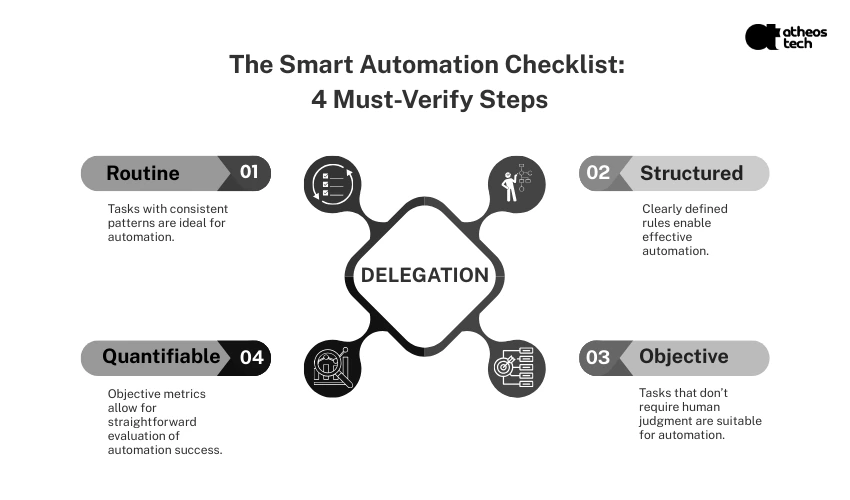
Hire UI UX Designer to Transform Your Brand Across Every Digital Channel

You’ve wrestled the chaos into submission in Phase 1. You’ve done the hard, strategic work of mapping your processes in Phase 2, as we laid out in our 3 Digital Phases guide. You’ve built a foundation.
And now you’re staring at the final prize: Automation.
It’s the siren song of ultimate efficiency. The promise of a business that runs itself, of exponential scale without exponential headcount. It’s the reward you’ve been working towards.
But here’s the brutal truth:
Most SMBs hit the gas on automation before they’ve built the road.
At AtheosTech, we’ve seen the wreckage from poorly planned small business IT solutions firsthand. Chatbots that alienate warm leads. Auto-emails that confuse loyal customers. CRM automations built on data that was never cleaned up. All built with the best intentions… and all slowly eroding ROI and reputation.
Let’s be clear: automation is not the villain.
Misuse is.
This guide isn’t a list of automation tools. It’s a list of rules.
It’s your blueprint for knowing what not to automate (yet), how to tell if your process is even ready, and what early wins to pursue without derailing your operations.
Because automation done right? > That’s scale.
But automation done wrong? > That’s expensive chaos dressed up as progress.
Let’s draw the line.
Before we can identify what not to automate, we have to correct a dangerous assumption many leaders make. When faced with a task that is overwhelming them or their team, they immediately ask,
“How can we automate this?”
That’s the wrong first question.
The right first question is: “Does a human need to do this?” This simple question forces you to choose between two very different, but equally powerful, tools in your leadership toolkit: delegation and automation.
Let’s settle a common misconception:
Delegation means handing a task to a human.
Automation means handing it to a machine.
Both are tools. Both save you time. But confusing the two is where chaos starts, and culture suffers.
Delegation In Practice: When a loyal, high-value client has a complex and frustrating support issue, you don’t send them a link to a generic FAQ page. You delegate that issue to your most experienced support specialist, who can listen, empathize, and solve the problem in a way that strengthens the relationship.
Automation In Practice: When that same client needs a copy of their last five invoices, you don’t need a human to manually dig through files and attach them to an email. You automate a system where they can log into a self-service portal and download them instantly, 24/7.
The trap many leaders fall into is trying to automate tasks that should simply be delegated to a trained and trusted team member.
If your first instinct is to replace people with bots, you’re not optimizing – you’re outsourcing leadership.
Your job isn’t to eliminate headcount.
Your job is to eliminate inefficiency.
And that starts with knowing when your team is the right tool, and when technology is.
Automation scales execution.
Delegation scales judgment.
You need both. But you need to know which one comes first.
Avoid the automation trap
Partner with experts who know when to act
In the race toward automation, many SMBs make the same mistake: they automate too early, and in the wrong places.
Ironically, the highest ROI from automation often comes not from where you use it… but from where you refuse to.
These aren’t inefficiencies. These are your competitive advantages. Treat them like crown jewels, not checkboxes on a system rollout.

Let’s be blunt: if your first impression is handled by a bot, don’t expect a second meeting.
What to Protect:
These moments are the business. Automate them, and you don’t just lose nuance – you lose trust.
“Your chatbot is not a CX strategist. Your drip email isn’t a closer. Know the difference.”
What You Can Automate:
Automation can support the relationship. But it should never own it.
Strategy is not a spreadsheet. Creativity is not a checklist.
Yet far too many businesses try to automate decisions that require taste, intuition, or vision.
What to Protect:
The Role of AI:
AI is an accelerator, not an architect.
It can help you draft, analyze, and ideate, but the final judgment call must come from a human with context.
Because while AI can mimic tone, only you understand what your brand stands for. And while it can suggest options, only you know which path aligns with your vision.
Automation thrives on routine. If your process isn’t predictable, it’s not automatable – it’s breakable.
What to Protect:
Trying to automate these is like building a conveyor belt for snowflakes: looks efficient, breaks instantly.
The Principle:
If you can’t write down the steps and repeat them consistently, you’re not ready to automate.
You’re ready to observe, document, and optimize – first.
When small business consulting firms assess automation readiness, this is where we start:
Not with “what can we automate?” but “what should we not?”
Because clarity isn’t just about where to move fast. It’s knowing where to slow down and think harder.
A seasoned small business consultant knows: automation isn’t about cutting heads – it’s about freeing up brains.
So far, we’ve told you what not to automate.
Now let’s flip the script.
Because if you’re wondering, “Okay, then where do we start with smart small business IT solutions?” – here’s your short list of green lights.
These are your ideal entry points: tasks that are repetitive, rule-based, measurable, and (most importantly) don’t require a brain or a brand voice.
The Scenario: Manually copying data from one system to another – from lead forms into spreadsheets, or CRM entries into invoicing tools.
Why It’s Safe: No judgment required. Just structured info, moved predictably.
Examples:
In Short: If the task makes your team feel like robots, let a robot do it.
The Scenario: Weekly sales dashboards. Monthly performance summaries. KPIs that never change but always need compiling.
Why It’s Safe: Same format. Same frequency. No surprises.
Examples:
Pro tip: Automating reporting doesn’t just save time – it enforces visibility and accountability.
The Scenario: Your team forgets follow-ups. Clients miss meetings. Leads go cold.
Why It’s Safe: These are reactive, rule-driven nudges – no emotional labor, no nuance.
Examples:
Cheat: Great automation keeps your team proactive – without anyone having to remember the calendar.
The Scenario: You’re getting leads, but not all are worth the time.
Why It’s Safe: Early-stage filtering doesn’t require sales finesse – just logic and form design.
Examples:
Shortcut: Let automation sort the haystack. Then let your humans close the needle.
Notice the theme? Each of these automations takes a robotic task off a human’s plate, freeing them up for the strategic work you actually hired them to do.

Before you automate anything, ask:
If the answer is yes across the board – automate away.
If not? Slow down. Revisit your process. Don’t build a machine you’ll later regret. First know where you stand in the 3 phases.
Let’s talk about eyeTalent – a fictional SaaS startup built on a very real mistake.
They didn’t scale with automation.
They tried to scale by replacing humans entirely.
eyeTalent was growing fast.
Mid-sized, 40 employees, healthy ARR – but stretched.
Leadership got swept up in the siren song of ultimate efficiency. They wanted to eliminate every “human bottleneck” from their sales and support funnel.
So, they did:
They called it streamlined.
Their customers called it something else: COLD.
The results came earlier than expected – and not the way they hoped for.
eyeTalent had built a well-oiled machine – but it was driving customers away. A qualified small business consultant would have spotted the red flags in eyeTalent’s strategy before the damage.
Here’s how we commanded them to turn the ship:
Slowly, trust came back. Conversion rates climbed. Churn leveled off.
They didn’t ditch automation. They just stopped treating it like a magic wand.
Tools don’t fail. Misuse does.
The small business IT solutions don’t fail. The lack of a strategy does.
eyeTalent’s mistake wasn’t ambition – it was skipping the strategy.
They forgot the core truth of every successful business:
Ultimate Truth: You don’t scale by removing people. You scale by making people more effective.
Let’s be clear:
You don’t automate because a tool looks sexy.
You automate because your business process earned it.
So, how do you know if a process is mature enough?
Before you spend a single dollar, here is the final, four-part litmus test a good small business consultant uses to give a go/no-go decision.
If you can’t answer a confident “yes” to all four questions, the process is not ready. You must pause and go back to the planning phase.
Question: Is the process stable, documented, and standardized?
If you can’t whiteboard it in five steps, you can’t automate it without risk.
Golden Rule: Never automate what you haven’t standardized.
Question: Is the task repetitive and predictable?
Automation loves sameness.
If each instance requires a different approach, it’s not ready
Question: Does it involve data, not subjective judgment?
Moving numbers between systems? Great.
Deciding whether a client needs Tier A or Tier B support? Still human territory.
Question: Is there a clear KPI to measure success?
If you can’t define success, don’t let a machine own the outcome.
Automation without accountability is just autopilot without a flight plan.
“If you haven’t standardized the process – don’t automate it.”
“If you can’t define success – don’t delegate it to a machine.”
Automation should feel like upgrading a well-running engine – not duct-taping rocket boosters to a rusted chassis.
When in doubt, delay.
Clarity before complexity.
Planning before platforms.
Start with strategy, not shortcuts. Let’s plan your digital roadmap.
So, here is the final, fundamental truth about automation: It is not the first step in your digital journey; it is the prize you earn for completing it correctly.
Let’s call it what it is:
Automation done too early isn’t innovation. It’s laziness in disguise.
Automation isn’t your plan.
It’s the execution layer that only works after you’ve built the right blueprint.
Don’t chase the siren song of “ultimate efficiency” at all costs. Chase clarity, stability, and value first. Build the right engine, then add the fuel.
The right small business consulting company helps you earn automation – not jump to it.
“If automation is your first move, you’re skipping the hard work – and inviting chaos.”
The businesses that win with automation aren’t the ones with the most tools. They’re the ones with the most clarity.
They know:
Because they did the unsexy work first – mapping processes, standardizing workflows, and aligning tech to actual business goals.
Let’s audit, before you automate.
Our consulting services for small businesses are built for SMBs like yours. We start with a Digital Maturity Assessment to help you identify…
As a dedicated small business consulting company, our first job is to bring clarity. Ready to scale the smart way?
Book a complimentary 30-minute Automation Readiness Assessment.
Adding {{itemName}} to cart
Added {{itemName}} to cart